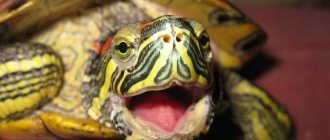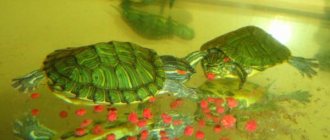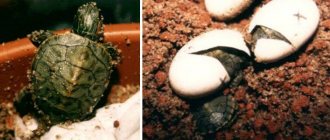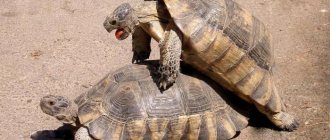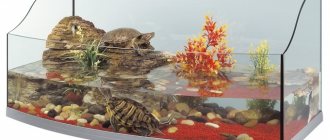Animal feed
It is best to build a diet based on animal food. The reptile's menu consists of 60% or more animal protein .
A turtle will happily eat any meat, but it is preferable to feed it lean varieties: beef, rabbit or poultry .
Attention! It’s a good idea to diversify your pet’s diet with fish, beetles and plants.
Meat
The aquarium red ear eats meat with pleasure, but how to feed it correctly and how many times a day so as not to harm it?
The basis of the diet is necessarily lean meat . Fatty lamb and pork will lead to digestive problems, illness and even death of the pet. In addition to the protein itself, the diet should contain by-products:
- heart;
- liver;
- stomachs.
You can occasionally feed your turtle small mice.
Important! A diet of only unprocessed meat is a direct path to vitamin A deficiency and rickets. You need to diversify the list of products, then your pet will be healthy.
What kind of fish is suitable for food?
What fish should you feed your red ear? As with meat, you need to choose lean varieties. First remove bones that can harm the turtle, as well as entrails and scales.
In addition, before serving, it is recommended to dip the fish in boiling water for a couple of minutes so that the thiaminase enzyme coagulates.
A cocktail made from sea creatures would be a good addition to your diet , but you shouldn’t give it often.
Attention! The redfish will not get along in an aquarium with fish and snails - this is its natural food supply.
Insects
What do red-eared turtles eat besides food? You will be surprised - insects! In summer they add to the menu:
- grasshoppers;
- caterpillars;
- bloodworm;
- mealworm;
- gammarus;
- daphnia (but in this case it is better to turn off the filter for a while).
Other animal food options
You should not feed your turtle caught cockroaches or spiders.
Insects can be “stuffed” with toxic substances, which will certainly harm your pet.
What to feed at home?
Under natural conditions it is an omnivorous predator. Red-eared turtles eat plant and animal foods with equal appetite. In nature, they hunt for small fish, snails, fry, crustaceans, and plankton. But for the strength and growth of the shell, the substances contained in food of animal origin are not enough, therefore plant food is definitely needed, from which the body receives vitamins and calcium.
The peculiarity of these turtles is that they eat in water, although it is quite possible to train them to eat on an island equipped in an aquarium, but this will take time and patience.
It is necessary to accustom it, since constant feeding in water leads to the fact that uneaten food quickly deteriorates, and an unpleasant odor begins to emanate from the aquarium.
To teach a turtle to take food on land, food is first placed near the very edge of the water. A hungry reptile will definitely take food. Then she is gradually accustomed to taking food from a small saucer into which a little water is poured.
If you wish, you can take the turtle out and feed it in a small plastic bowl of water. In this case, the water in the aquarium will remain clean for the longest time.
Pond slider
Plant food
The diet of an adult turtle should be dominated by plant components . The older she is, the more vegetarian dishes are on the menu.
Grass
Little Reds eat their coltsfoot with gusto. Also great for:
- leaves of plantain, clover, dandelions;
- sprouted oats and barley.
Aquarium plants
Seaweed is a good addition to the menu. Duckweed, watercress and any plants from natural bodies of water are suitable
Vegetables
Turtles love kibble:
- bell peppers;
- zucchini;
- eggplant;
- cucumbers;
- tomatoes;
- carrots;
- beets;
- pumpkins.
Mushrooms
Once a week, champignons, russula or boletus , cut into small pieces, are added to the regular diet.
Features of feeding small turtles
Particular attention must be paid to feeding turtles, because a deficiency of vitamins can negatively affect their development.
Young turtles are predatory animals, so they often ignore plant foods. Animal food plays a predominant role during their feeding period. They require food 1 or even 2 times every day.
Juveniles desperately need calcium and vitamin D. They should be added to their food at every feeding.
Baby turtles desperately need calcium and vitamin D intake
One of the rules for feeding baby turtles is to serve pieces of food the size of a blueberry.
Artificial feed
Pet stores generously offer a wide variety of food for turtles , but such mixtures do not cover the reptile’s need for proteins and microelements.
Homemade food
If store-bought food is not suitable for your turtle, you can prepare the food yourself.
Take:
- 50 g cabbage;
- 70 g carrots;
- 150 g lean fish;
- 50 g apples;
- 100 g squid meat.
The products are passed through a meat grinder or crushed with a blender . Add 2 eggs, gelatin (1 tablespoon per 150 ml of water) and 150 ml of milk to the mixture. Mix everything thoroughly and store in the refrigerator for no more than a week.
This amount of food is enough for about 10 servings for one small turtle. Before serving, food is cut into portions.
Is it possible to give turtles dog/cat food?
Although turtles eat commercial cat and dog food with great pleasure, such a diet does not benefit them.
Such mixtures do not contain the microelements necessary for reptiles, and abuse of such a diet will lead to serious health problems for the turtle .
What do turtles eat in the wild?
The main component of the diet of red-eared turtles in the wild are shellfish: mussels and snails, oysters, and crustaceans. They have no teeth, but this does not prevent them from excellently dealing with mollusk shells: with strong jaws they break them and eat the pulp.
In the summer, insects become food for turtles: grasshoppers, beetles, etc.
They are very fond of algae, plankton and small fish. They also eat tadpoles, fish fry and frogs.
Vitamin and mineral complexes
Turtles need calcium to form their shell. fill the need for microelements with the help of bone meal - it is mixed into the food.
A pinch is enough for young redears; for older ones, a teaspoon is “stretched” for a week.
In addition, special vitamins for turtles are added in accordance with the instructions, but the shelf life of such food is limited.
Drinking regime
Red-eared turtles from the family of freshwater turtles live in the wild in small lakes with well-warmed water by the sun or ponds with swampy shores. For these reptiles, fresh water is vital (they cannot live without it for even a couple of days). The redfish spends its entire life in water - activity and sleep, eating and the process of defecation.
The red-eared turtle spends its entire life in water - activity, sleep, eating
The question of whether a turtle has a need to drink has not been fully studied. The structural features of her body do not allow water to linger: in the process of drinking, it pours out of her nostrils and flows down her neck. Moisture, so necessary for reptiles, penetrates through its skin, as well as from the products it eats.
Getting ready to purchase
About 80 percent of people who started reading this article will think - what is the purpose of preparing, bought an aquarium and went after a turtle. It couldn't be simpler. But it turns out that everything is not so simple
And we will emphasize the importance of preparing for buying a turtle using the example of a specific family from the city of Moscow, into whose life a small green cute thing named Rafa burst into
The appearance of the animal caused unimaginable delight, and, naturally, it was necessary to urgently solve the turtle’s housing problem. The first aquaterrarium was purchased and furnished on the same day, and Rafa rushed to explore the new home. Why the first? Some nuances should have been known about reptiles, as it turned out a little later.
Not a single seller of terrariums on the market told buyers that after 2-3 years a 30-liter container will no longer be enough for a turtle. After all, animals grow to the size of a good plate of soup in the size of a shell.
No one said that red-eared turtles are not hamsters, they live 2-3 years and the owner is allowed to choose a new pet. In captivity, red-eared turtles live up to 50 years. And you should approach the question responsibly: are you ready to take care of this pet for half a century, or is it not for you.
Well, and the most interesting thing is that when asked about feeding, the sellers named different types of food, but forgot to mention the main point - if you feed the animal with meat, the turtle will develop the habit of biting. And with a high degree of probability, by the age of 5 the creature will become simply dangerous to pick up and try to play with it.
Still have the desire to buy such a pet? Then let's figure out what to feed the turtle.
Natural habitat
The first individuals were brought from the southern states of America, Mexico, Colombia and Venezuela. Nowadays you can meet it in almost every corner of the world. Great popularity contributed to such wide distribution.
For living it chooses reservoirs with fresh water, with dense thickets. Wetlands, ponds and lakes are also suitable. The bottom covering is preferred to be muddy or sandy. They leave the aquatic environment in order to warm up under the sun's rays, but do not go far from the water.
Feeder for turtles. How do land and aquatic turtles eat?
- turtle-home
- 14-01-2017, 00:15
- 1 165
Keeping turtles / Feeding turtles
Even in the kingdom of reptiles, where only deep archaic instincts are honored, culture can be found. Experienced turtle owners already know that having worked up a fair appetite and smelled the aroma of their favorite food, once wild reptiles turn into the most disciplined, attentive and grateful creatures in the world. When starting a meal, the whole world disappears from the turtle’s attention. You can observe with interest (or even envy) how thoroughly and with gusto the reptile chews its food. Why not culture? And it’s doubly interesting to watch your pet’s behavior if the reptile is provided with good conditions for eating. Which feeder is best for a red-eared turtle? And what kind of dishes is best to offer to a land reptile?
Turtle feeder
Prohibited Products
In addition to recommendations containing a list of the best foods for the development of a pet, there is also a list of prohibited foods that should not be given to turtles under any circumstances. This:
- flour products: bread, buns, etc.;
- spinach, peas, rhubarb;
- tomatoes;
- citrus fruits: oranges, tangerines, grapefruits, pomelo;
- nuts;
- lamb, pork;
- dairy products: cottage cheese, milk, sour cream;
- fried or boiled food;
- cheese;
- radish;
- White cabbage;
- mushrooms;
- food intended for fish or other animals;
- fruit seeds;
- fatty fish;
- squid;
- crab sticks.
Red-eared turtles are predatory creatures, and with proper care, the creatures can delight the owner with a funny appearance and longevity. One of the most important aspects of keeping and caring for turtles is the diet, because only when fed with high-quality, fresh and varied food will the pets not get sick.
How long can a turtle not eat?
A red-eared slider may not eat at all for 10 to 90 days; this period is individual for each individual. Young turtles can starve for the least amount of time. In this case, reptiles can lose up to 40% of their mass. But you should not starve them; you should offer food regularly.
When keeping such turtles at home, it is necessary to create feeding conditions for them that are as close to natural as possible. And then the pet will be able to remain active and healthy for a long time.
What do you feed your red-eared pet? Share your experience in the comments.


